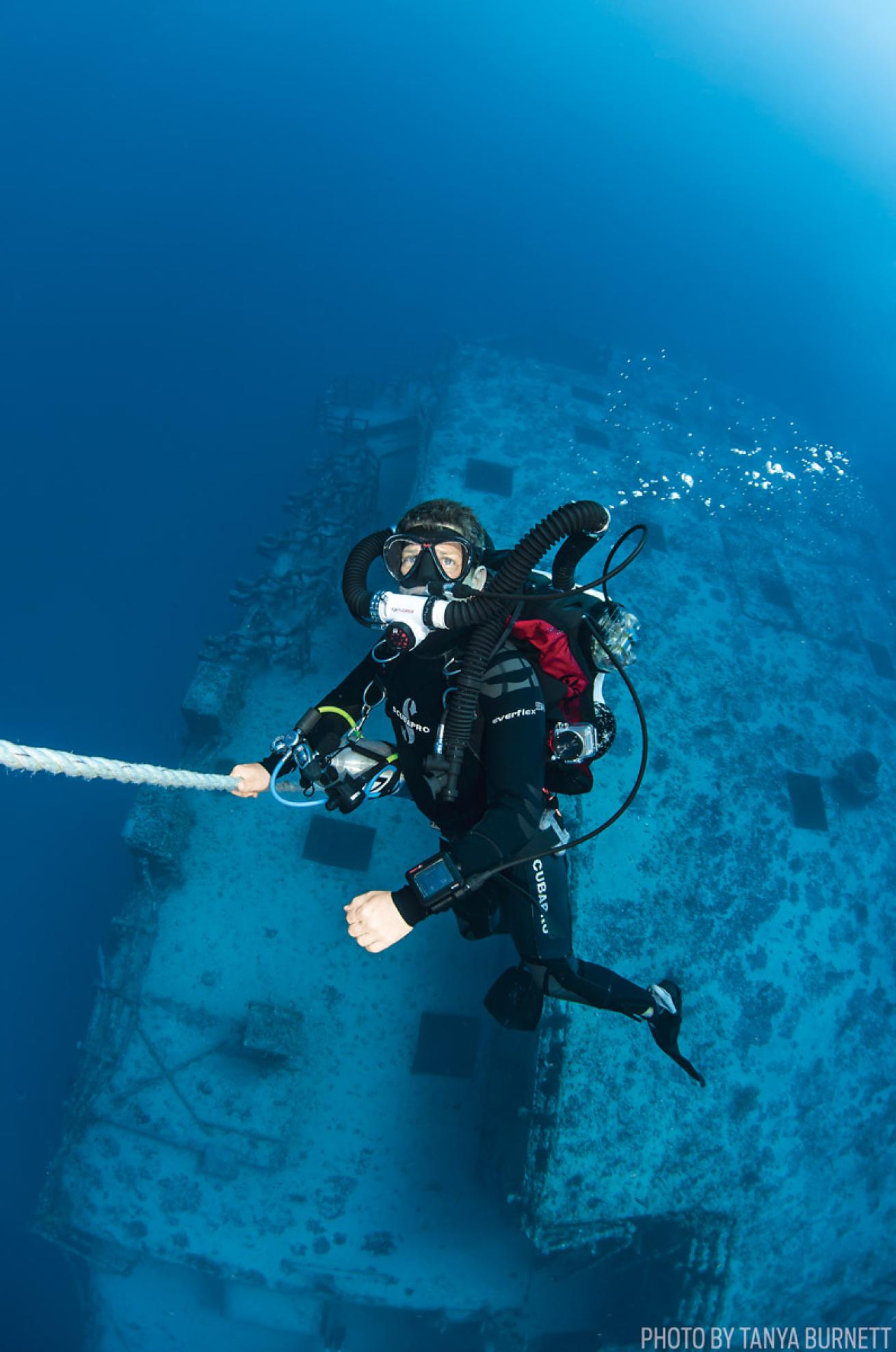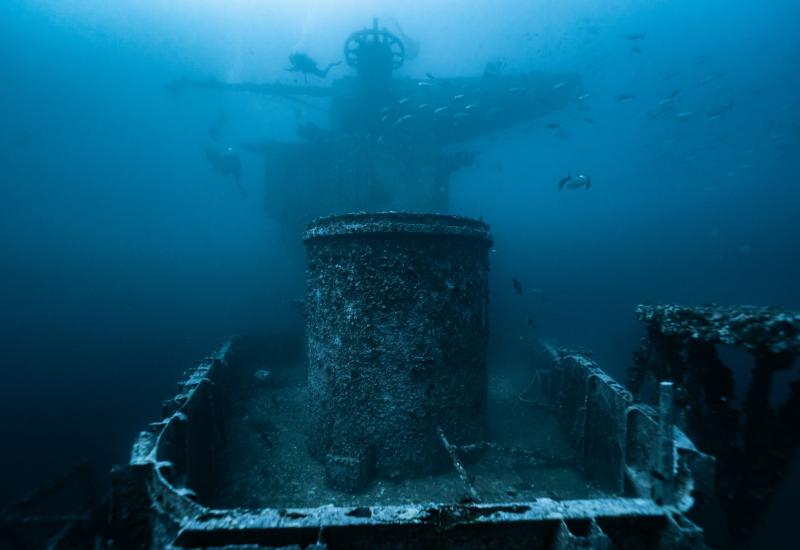Dive Hacks: Tips for Wreck Diving

Shipwrecks are magnetic to divers. Mysterious, poignant and sometimes haunting, sunken ships have compelled humankind since we first figured out a way to breathe underwater. There’s something seductive about the hidden treasures they harbor in their rusty bellies, and some of the world’s most popular dive destinations owe their fame to wrecks.
From the historic warships of Chuuk Lagoon, Palau, Bikini Atoll and the Scapa Flow to the man-made attractions of the Florida Keys, New Zealand, Grand Cayman and Australia, the draw of artificial reefs is global. But sunken ships pose unique challenges to divers, including the potential for entanglement in fishing line, laceration by sharp metal or becoming lost deep in their bowels. Specific training and equipment are prudent when attempting any wreck dive, and there’s no quick and easy substitute for experience.
Robert Purifoy of Olympus Dive Center in Morehead City, North Carolina, has been intrigued by shipwrecks since before he was old enough to become certified. As the son of North Carolina pioneer George Purifoy, who was instrumental in discovering such famous regional sites as the U-352 and the USS Schurz, he started working on dive boats at age 10, earned his instructor rating in 1990, and now runs charters as captain of the 65-foot Olympus.
“The older shipwrecks that were true warships and have a history are fascinating to me,” says Purifoy. “Other wrecks I like for the marine life that congregates around them. Artificial or historic — every wreck has its own unique appeal.”
His backyard on the fabled Outer Banks of North Carolina boasts wrecks sunk on purpose and by tragic events, and offers a variety of challenges, from depth to size, condition and beyond.
“The U-352 is my favorite wreck, for sure. It’s easy to navigate and one of those bucket-list dives because of the history,” Purifoy says. “Another favorite is one of the newer ships that was sunk as an artificial reef, the USCGC Spar, because it’s got a lot of relief, sits close to the Gulf Stream for consistent good visibility, and is usually inhabited by quite a few sand tiger sharks.”
It’s a world-class training ground for wreck divers— here are four choice lessons from Purifoy’s logbook.
PREPARE FOR ACTION
Wreck diving can become complicated and strenuous. Before your next expedition (or local artificial reef ) consider the added benefit of taking a specialty course, having your gear serviced and increasing your normal workout.
“A little preparation goes a long way, and training is the first step,” Purifoy says. “We always recommend that people come out early and do a shallow warm-up dive to make sure they have their weight right, their computer is working properly, and there’s nothing else that might cause them to miss the dive. There’s nothing more disappointing than making it to that bucket-list wreck dive and everything goes as planned except for you.”
LEARN THE HISTORY
Finding out the layout and back story of a sunken ship can aid in navigation, clue you in to cool features and create a deeper appreciation for what you’re experiencing. Purifoy says your best source for information is always the local dive professionals, who have likely explored most every inch of the wrecks in their region.
“Knowing the history of the ship makes it come alive,” says Purifoy. “Beyond that, it helps you to set goals or objectives for your dive. Otherwise, you might surface and hear everyone else on the boat saying, ‘Wow, did you see that big propeller?’ And you’re thinking, ‘What propeller?’”
CONSERVE THE KICKS
Although there’s no substitute for proper buoyancy (which should be perfected before attempting a penetration), inside a wreck (after the proper training), limiting the amount of kicking you do will decrease the risk of a siltout or debris falling from an overhead environment.
“When penetrating a wreck that has a good water flow and visibility, I use a pull-and-glide technique as opposed to kicking,” says Purifoy. “It’s a technique that cave divers often use where you reach out and carefully take a handhold to give yourself a pull and just glide. If it’s a tight space where there’s not a lot of water moving, I use a very careful frog kick.”
TAKE THE RIGHT TOOLS
The rigors of wreck diving require specialized gear to solve specific problems. Packing along a bright light to illuminate the dark corners, a clean slate to diagram structural features, a reel and line to mark your path through winding corridors, and a sharp cutting tool to shred potential entanglements can increase your safety and enjoyment.
“With the proper training, I recommend a stage bottle, especially for penetration,” Purifoy says. “In addition, I recommend a dual-outlet-valve system where you have two first stages, so if you were to have a hose get cut or break, you could turn one of those valves off and still have a fully independent scuba unit to complete your dive.” His redundancy strategy can be carried over into other accessories as well, from dive computers to torches. “I always dive with at least two computers, or at least a computer and a secondary timing device,” says Purifoy. “And keep in mind that your backup light needs to be as good as your primary light because it may become your primary light.”
GEAR SOLUTIONS
The right tools — including a multipurpose cutting tool—increase your safety when wreck diving.

This clever unit combines the strength of a knife with the utility of scissors in a single compact package (6.5 inches in length) that can fit comfortably inside most BC pockets. For added function, the blade is serrated to increase its bite and the shears are spring-loaded for easy use with gloves. Plus, it’s built from corrosion-resistant stainless steel, offers rubber handle inserts to ensure a positive grip, and stows neatly into a low-profile molded sheath.
MSRP $74.95; INFO cressiusa.com
Shipwrecks are magnetic to divers. Mysterious, poignant and sometimes haunting, sunken ships have compelled humankind since we first figured out a way to breathe underwater. There’s something seductive about the hidden treasures they harbor in their rusty bellies, and some of the world’s most popular dive destinations owe their fame to wrecks.

Tanya BurnettShipwreck fanatic (aka metal head) Robert Purifoy talks wreck diving.
From the historic warships of Chuuk Lagoon, Palau, Bikini Atoll and the Scapa Flow to the man-made attractions of the Florida Keys, New Zealand, Grand Cayman and Australia, the draw of artificial reefs is global. But sunken ships pose unique challenges to divers, including the potential for entanglement in fishing line, laceration by sharp metal or becoming lost deep in their bowels. Specific training and equipment are prudent when attempting any wreck dive, and there’s no quick and easy substitute for experience.
Robert Purifoy of Olympus Dive Center in Morehead City, North Carolina, has been intrigued by shipwrecks since before he was old enough to become certified. As the son of North Carolina pioneer George Purifoy, who was instrumental in discovering such famous regional sites as the U-352 and the USS Schurz, he started working on dive boats at age 10, earned his instructor rating in 1990, and now runs charters as captain of the 65-foot Olympus.
“The older shipwrecks that were true warships and have a history are fascinating to me,” says Purifoy. “Other wrecks I like for the marine life that congregates around them. Artificial or historic — every wreck has its own unique appeal.”
His backyard on the fabled Outer Banks of North Carolina boasts wrecks sunk on purpose and by tragic events, and offers a variety of challenges, from depth to size, condition and beyond.
“The U-352 is my favorite wreck, for sure. It’s easy to navigate and one of those bucket-list dives because of the history,” Purifoy says. “Another favorite is one of the newer ships that was sunk as an artificial reef, the USCGC Spar, because it’s got a lot of relief, sits close to the Gulf Stream for consistent good visibility, and is usually inhabited by quite a few sand tiger sharks.”
It’s a world-class training ground for wreck divers— here are four choice lessons from Purifoy’s logbook.
PREPARE FOR ACTION
Wreck diving can become complicated and strenuous. Before your next expedition (or local artificial reef ) consider the added benefit of taking a specialty course, having your gear serviced and increasing your normal workout.
“A little preparation goes a long way, and training is the first step,” Purifoy says. “We always recommend that people come out early and do a shallow warm-up dive to make sure they have their weight right, their computer is working properly, and there’s nothing else that might cause them to miss the dive. There’s nothing more disappointing than making it to that bucket-list wreck dive and everything goes as planned except for you.”
LEARN THE HISTORY
Finding out the layout and back story of a sunken ship can aid in navigation, clue you in to cool features and create a deeper appreciation for what you’re experiencing. Purifoy says your best source for information is always the local dive professionals, who have likely explored most every inch of the wrecks in their region.
“Knowing the history of the ship makes it come alive,” says Purifoy. “Beyond that, it helps you to set goals or objectives for your dive. Otherwise, you might surface and hear everyone else on the boat saying, ‘Wow, did you see that big propeller?’ And you’re thinking, ‘What propeller?’”
CONSERVE THE KICKS
Although there’s no substitute for proper buoyancy (which should be perfected before attempting a penetration), inside a wreck (after the proper training), limiting the amount of kicking you do will decrease the risk of a siltout or debris falling from an overhead environment.
“When penetrating a wreck that has a good water flow and visibility, I use a pull-and-glide technique as opposed to kicking,” says Purifoy. “It’s a technique that cave divers often use where you reach out and carefully take a handhold to give yourself a pull and just glide. If it’s a tight space where there’s not a lot of water moving, I use a very careful frog kick.”
TAKE THE RIGHT TOOLS
The rigors of wreck diving require specialized gear to solve specific problems. Packing along a bright light to illuminate the dark corners, a clean slate to diagram structural features, a reel and line to mark your path through winding corridors, and a sharp cutting tool to shred potential entanglements can increase your safety and enjoyment.
“With the proper training, I recommend a stage bottle, especially for penetration,” Purifoy says. “In addition, I recommend a dual-outlet-valve system where you have two first stages, so if you were to have a hose get cut or break, you could turn one of those valves off and still have a fully independent scuba unit to complete your dive.” His redundancy strategy can be carried over into other accessories as well, from dive computers to torches. “I always dive with at least two computers, or at least a computer and a secondary timing device,” says Purifoy. “And keep in mind that your backup light needs to be as good as your primary light because it may become your primary light.”










